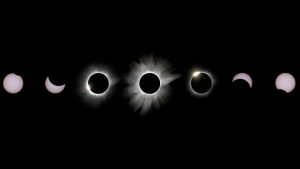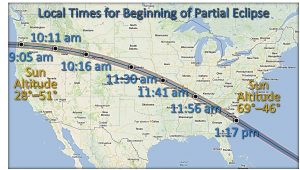There’s only another month to go before the United States is treated to a total solar eclipse that will stretch across the entire continent beginning in Oregon and ending in South Carolina. Occurring on Monday the 21st of August this eclipse will be the grandest astronomical event to take place in our skies for over a hundred years and I hope that many of you will be able to enjoy at least some of the show.

If you are planning on taking part in the fun please heed this warning:
DO NOT LOOK DIRECTLY AT THE SUN: EVER!!!!!!
Every time a good solar eclipse occurs hundreds of people injure their eyes by not taking the necessary precautions. And it is so easy to get glasses that will give you all the protection you need. Seriously, Wal-Mart has them, Amazon has them, dozens of retailers are selling eclipse glasses for prices starting at $10 so please get a pair!!!
Now everybody knows that a solar eclipse is caused by the Moon passing in front of the Sun from our point of view here on Earth. (A lunar eclipse on the other hand is caused when the Earth passes between the Sun and the Moon) However many people are unsure of some of the details, such as the difference between the Umbra, where you get a total eclipse, and the Penumbra where you only get a partial eclipse.
Looking at the figure below from NASA you can see that while the Sun is much larger than the Moon (its diameter is about 4000 times larger) it is also much farther away from Earth (about 4000 times further). That’s why they look almost exactly the same size in our sky. Following the lines of the Sun’s outer edges you can see how the Moon blocks some of the light from the Sun over a large swath of the Earth’s surface (this is the Penumbra) but only completely blocks the Sun over a small region (this is the Umbra) and only for a very short period of time.

To see a total eclipse, to see the stars and planets come out in the daytime and to see the Sun’s corona you must be within the narrow band of the Umbra. The map below shows the path of the Umbra across the US with the local times that totality will occur. If you’d like to get a more detailed map of your area click on the link below the map to be taken to NASA’s special website for this eclipse.

https://eclipse2017.nasa.gov/eclipse-maps
Now my hometown of Philadelphia is nowhere close to the path of totality so I’m heading to Nashville, Tennessee, which is one of several major cities within the path of totality, and only a few miles from the point of maximum duration. Now I’m just keeping my fingers crossed that the weather is clear on eclipse day. There’s actually a long history of astronomers and other scientists making long journeys to witness and study total eclipses only to wind up see nothing but clouds.
There’s another big total eclipse coming seven years from now in 2024. That one will be closer to me, crossing Ohio, western Pennsylvania and much of New York so hopefully I’ll get another chance if this year’s eclipse doesn’t work out. So wish me luck, and I’ll do the same for you. If things go well I’ll be able to share some great pictures with you in just a few weeks.
